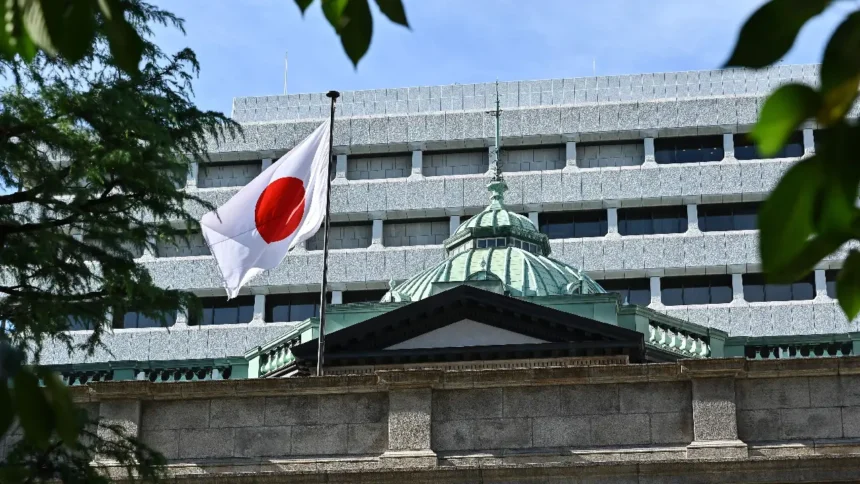Exports slump under U.S. tariffs as Tokyo evaluates policy response
Japan’s economy contracted by an annualised 1.8 percent in the July‑to‑September quarter, the first decline in six quarters, as weakening exports tied to U.S. tariffs weighed heavily on growth.
What the Numbers Show
Japan’s gross domestic product (GDP) fell 0.4 percent quarter‑on‑quarter during the latest quarter, marking a clear reversal from the 2.3 percent annualised growth in the prior period. The drop was driven primarily by a decline in exports, which fell approximately 1.2 percent from the prior quarter and 4.5 percent on an annualised basis. Imports edged down 0.1 percent. In contrast, private consumption — which accounts for the majority of economic output — grew just 0.1 percent, showing remarkably weak domestic demand. Capital expenditure (business investment) rose by 1.0 percent, positive but modest in context. Housing investment slowed considerably amid regulatory changes, adding to the headwinds.
Why Exports Took a Hit
The major export drag came amid the backdrop of higher U.S. tariffs on Japanese imports. Tokyo and Washington reached a deal that imposed a baseline 15 percent tariff on nearly all Japanese goods during September, although earlier threatened rates had been significantly higher. Japanese manufacturers, especially automakers, had rushed to front‑load exports before the tariffs took effect, inflating prior numbers and leaving a drop behind when shipments normalised. Automakers also reportedly absorbed some tariff costs by cutting unit prices, which squeezed margins and reduced export values.
Net external demand — the difference between exports and imports — subtracted 0.2 percentage point from GDP growth in the quarter, reversing the positive contribution seen in the previous quarter. That shift underscores how vulnerable Japan remains to global trade shocks and policy changes.
Domestic Demand: Weak but Holding
Despite the export slump, the domestic side of the economy exhibited modest resilience. Household consumption rose 0.1 percent, defying the sharper contraction some analysts expected, but still indicating a near‑stall in spending. Consumer caution seems to be growing amid higher food and energy prices, coupled with stagnant real wages. Business investment grew, which is encouraging, but that alone may not be enough to offset the drag from exports and housing.
Housing investment, in particular, took a noticeable hit. Tighter energy‑efficiency regulations introduced earlier in the year appear to have delayed construction commitments and weighed on activity in that segment. While this may be a short‑term drag, it points to structural challenges in parts of Japan’s economy.
Implications for Policy and the Bank of Japan
For the Bank of Japan (BOJ) and Tokyo’s policy makers, the contraction presents a tricky balancing act. On one hand, with inflation above target and the defence of monetary policy credibility at stake, the BOJ had been preparing for possible interest‑rate increases. On the other hand, weak growth and external shocks raise the risk of policy mis‑timing.
Economists say this quarter’s data alone may not signal a broader recession, given the limited scope of the decline and the ongoing strength in some domestic indicators. Many see this as a temporary setback rather than a full‑blown downturn, pointing to capital spending and slight consumption gains as signs that underlying momentum may not be completely gone.
Still, advisers close to the government argue that the contraction strengthens the case for fiscal stimulus. Indeed, Japan’s finance ministry is reportedly preparing a large‑scale stimulus package — in excess of 17 trillion yen (around $110 billion) — aimed at boosting household income and counteracting rising living costs.
Broader Economic Context
Japan’s economy has long faced structural challenges: ageing population, wage stagnation, high public debt, and periodic external shocks. The latest contraction underscores how trade policy shifts – especially tariffs from major partners – can have outsized effects given Japan’s open trade profile.
It also raises questions about how companies adapt. The front‑loading of exports before tariff changes suggests some of the current weakness may be transitional. Still, firms may need to adjust production, diversify markets, or absorb cost pressures longer‑term. This may weigh on investment and hiring decisions going forward.
What Comes Next and Risks
Looking ahead, two scenarios stand out:
-
Recovery scenario: If exports rebound, consumption accelerates modestly, and stimulus supports momentum, the economy could grow again in the October‑December quarter. Some forecasts expect around 0.6 percent growth for that period.
-
Risk scenario: If tariffs deepen, global demand softens, or domestic consumers remain cautious, the economy could slip into stagnation. That would intensify pressure on monetary and fiscal policy and heighten election‑cycle risks.
Key things to watch: export data in the next quarter, how consumers respond to stimulus and real wage changes, and whether housing investment stabilises. Another important variable is the yen – a weaker currency can help exporters but also drives up import costs and squeezes consumers.
Final Thought
Japan’s economy entering contraction for the first time in six quarters highlights the fragility of growth amid rising trade tensions and domestic headwinds. While the drop may reflect a correction more than a collapse, the episode reminds policy‑makers that external vulnerabilities and structural issues remain very real. How Tokyo, the BOJ, and Japanese business respond in the coming months will determine whether this becomes a brief stumble or the start of a more sustained slowdown.











